Getting the Best out of an Ivy Bridge HTPC: Windows 8, madVR and More..
by Ganesh T S on January 20, 2013 3:00 PM EST- Posted in
- Home Theater
- Intel
- HTPC
- Ivy Bridge
- Windows 8
- Passive Cooling
General Performance Metrics
We are not going to compare our build with full-blown desktop solutions. Instead, we will see how the unit stacks up to some of the low power offerings that have graced our labs. Some of the benchmarks have been run for the first time, and hence, not all benchmarks are available for all units. In addition, we are only presenting benchmark results for our build under Windows 8.
Windows Performance Index
This metric is often considered meaningless, but we feel it serves as an indicator of what could be the bottleneck in a system. On Windows 8, systems can score up to 9.9 on this metric, compared to 7.9 on Windows 7.

Given that we have equipped the system with SSDs and the RAM runs at the prescribed maximum of 1600 MHz, it is no surprise that the HD 4000 GPU is responsible for a score of 4.7 for the system.
Futuremark Benchmarks
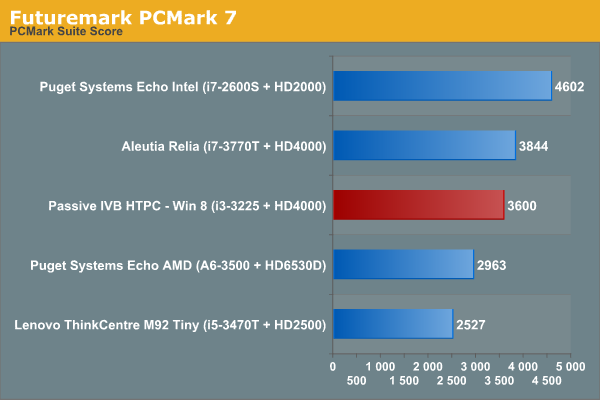
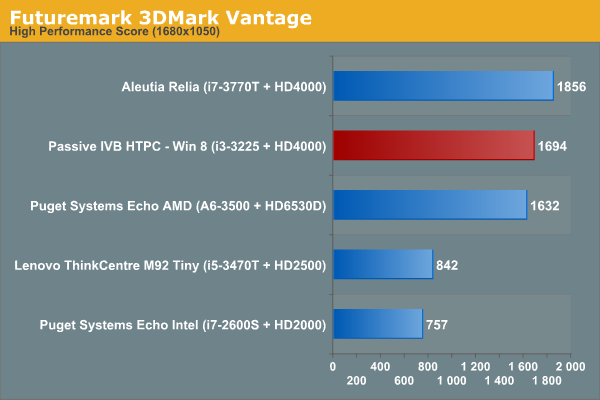

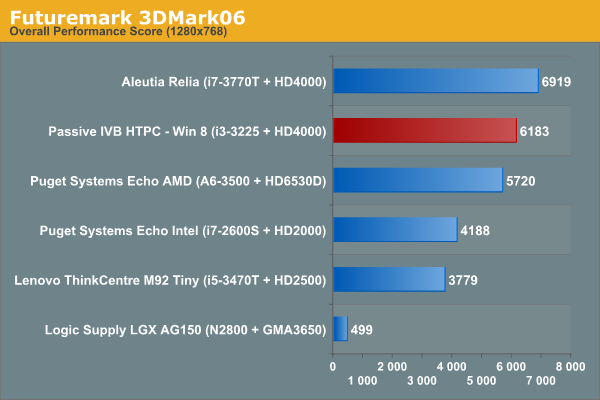
Miscellaneous Benchmarks
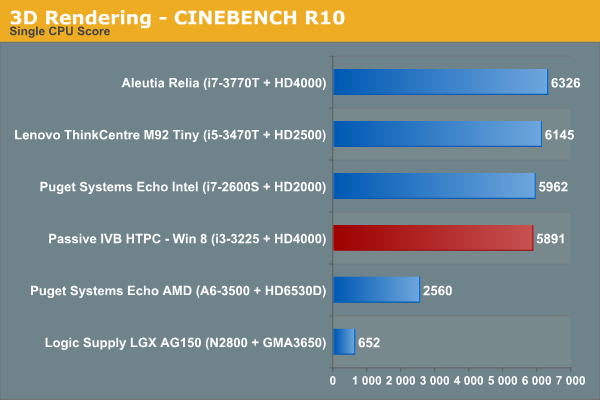
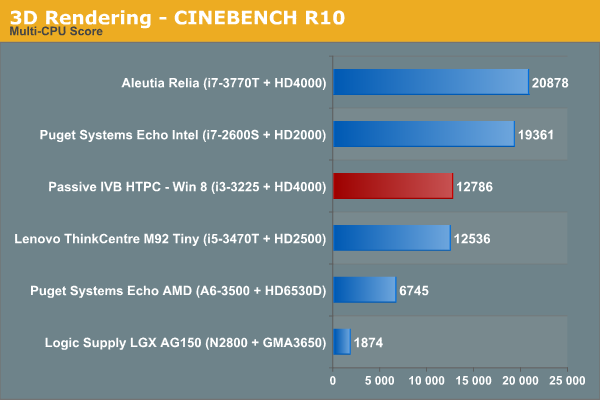
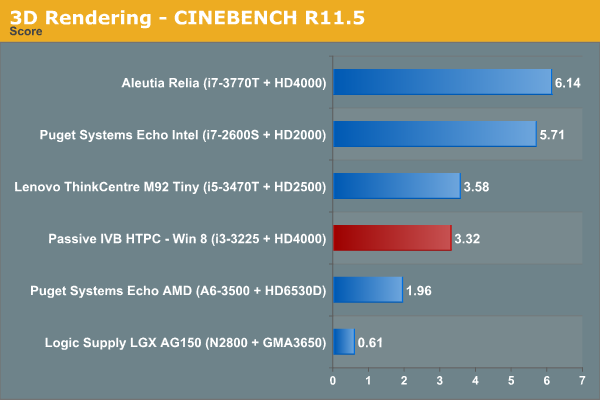
Starting with this review, we are going to utilize Graysky's x264 Benchmark v5.0 for testing out x264 encoding performance. Instead of just presenting benchmarks for our build alone, we took the opportunity to run the benchmark on two HTPC units we reviewed earlier.

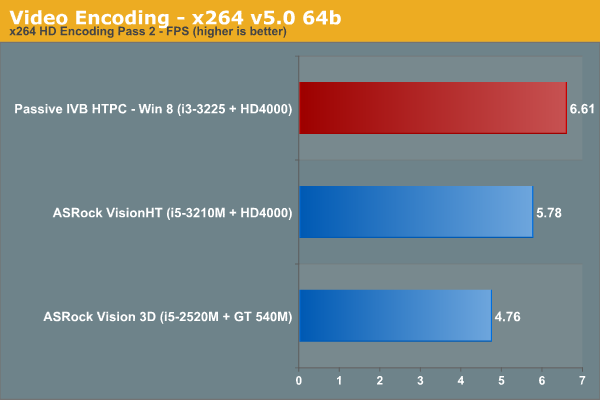
There are no surprises in the benchmarks, with the CPU performance befitting a 55W TDP unit. The absence of four physical cores does hurt it against the i7-based units in the above graphs (and would have showed in the x264 benchmark too, if we had run it on a i7-based system). However, this is not a concern for most HTPC workloads.










138 Comments
View All Comments
HighTech4US - Sunday, January 20, 2013 - link
Agree, I see no other overall complete platform that would be better (or even equal) for a 4-OTA Tuner DVR with unlimited storage (only limited by disk size) with free EPG that Windows 7 Media Center provides.And by tricking out 7MC with MediaBrowser, MediaControl, SHARK007 Codecs I have a complete on demand system that can play any type of media.
I use MediaCenterMaster to get program meta information, backdrops and thumbnails for MediaBrowser.
I also use MakeMKV to rip my DVD's and VideoReDo TVSuite h.264 to edit recorded TV shows and convert them to H.264 MKV's.
Oh and 7MC can show your digital pictures as a slide show on your big screen with background music.
I also love the screen saver where it shows random pictures from your picture library then zooms to one (or more) from a folder. When I first got this enabled the wife spent 45 minutes just watching the screen saver.
powerarmour - Monday, January 21, 2013 - link
Agreed, WMC is only EPG based Tuner app that can correctly use Freeview HD DVB-T2 Tuners in the UK, there are no other usable HTPC alternatives.psuedonymous - Sunday, January 20, 2013 - link
Question: why was the obsolete 2-pass method used instead of the faster (and more common) CRF? Was the encoding benchmark intended as an artificial CPU-stressing benchmark rather than a 'real world' encoding benchmark?ganeshts - Sunday, January 20, 2013 - link
Hmm.. that is what Graysky's benchmark does, and it keeps the setting consistent across different systems when you want to see how much better or worse your system is, when compared to someone else's.FWIW, pass 1 stresses the memory subsystem, while pass 2 stresses the CPU.
ganeshts - Sunday, January 20, 2013 - link
Thanks for the info. I was looking at the FAQ hosted by TechARP here: http://www.techarp.com/showarticle.aspx?artno=442&... ;Also, look at Ian's test with various memory speeds here using the same processor (last section on this page):
http://www.anandtech.com/show/6372/memory-performa...
There is definitely an impact on pass 1 performance using different memory speeds and the impact is more than on pass 2.
Iketh - Sunday, January 20, 2013 - link
Why is Prime95 v25.9 used? That is grossly outdated. The latest official 27.7 is needed to tax Ivy Bridge with AVX instructions. All those temps and watts you got will increase significantly. Please revise your Prime95. An oversight like this is unacceptable.Not to mention the latest Intel compilers have been implementing AVX instructions for like 6+ months now even if the programmer didn't specifically write for it. AND Handbrake has been using AVX in about that same timeframe and is only increasing.....
ganeshts - Sunday, January 20, 2013 - link
I will definitely do some experiments with the new Prime95 and report back.ganeshts - Monday, January 21, 2013 - link
I repeated the CPU loading with the latest Prime95 (v27.7):http://i.imgur.com/lK0zqjR.png
The readings didn't go up significantly, but, yes, there is an increase. The power consumption at the wall increased from 58.25 to 62.56 W.
Thanks for bringing this to our attention, and we will make sure future reviews use the updated Prime95.
ganeshts - Monday, January 21, 2013 - link
Oh, but, with full GPU and CPU loading (using Furmark 1.10.3 - latest), the power at the wall is only 89.77 W (compared to 88.75 W earlier). The ~40 W / ~15W TDP distribution between the CPU and the GPU still remains the same.http://i.imgur.com/soCGAyk.jpg
I don't expect the steady state temperatures to be that different because the power increase at the wall is only 1 W.
ganeshts - Sunday, January 20, 2013 - link
Yes, the scaling algorithms affect the performance a lot.That is why I mentioned that we used the default settings: Bicubic with sharpness 75 for chroma (no anti-ringing filter), Lanczos 3-tap for image upscaling / Catmull-Rom for image downscaling (no anti-ringing filter or linear light scaling),
We will look at other scaling algorithms and their performance on the HD 4000 / GT 640 / AMD 7750 in the third part of the HTPC series.
Also, a note that if you are using HD 4000 (or any other Intel HD Graphics), I would strongly suggest looking at DXVA Scaling. Users might be surprised at the quality delivered without taxing the GPU too much.